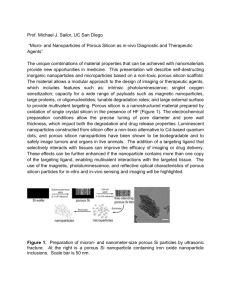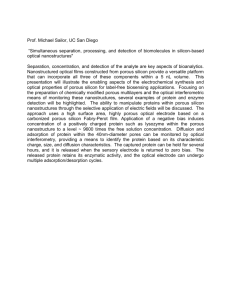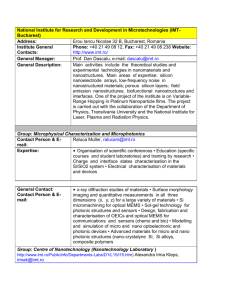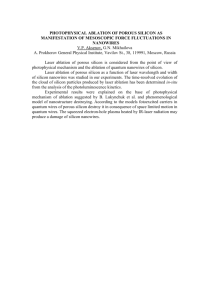Porous Silicon and its Applications to MEMS
advertisement
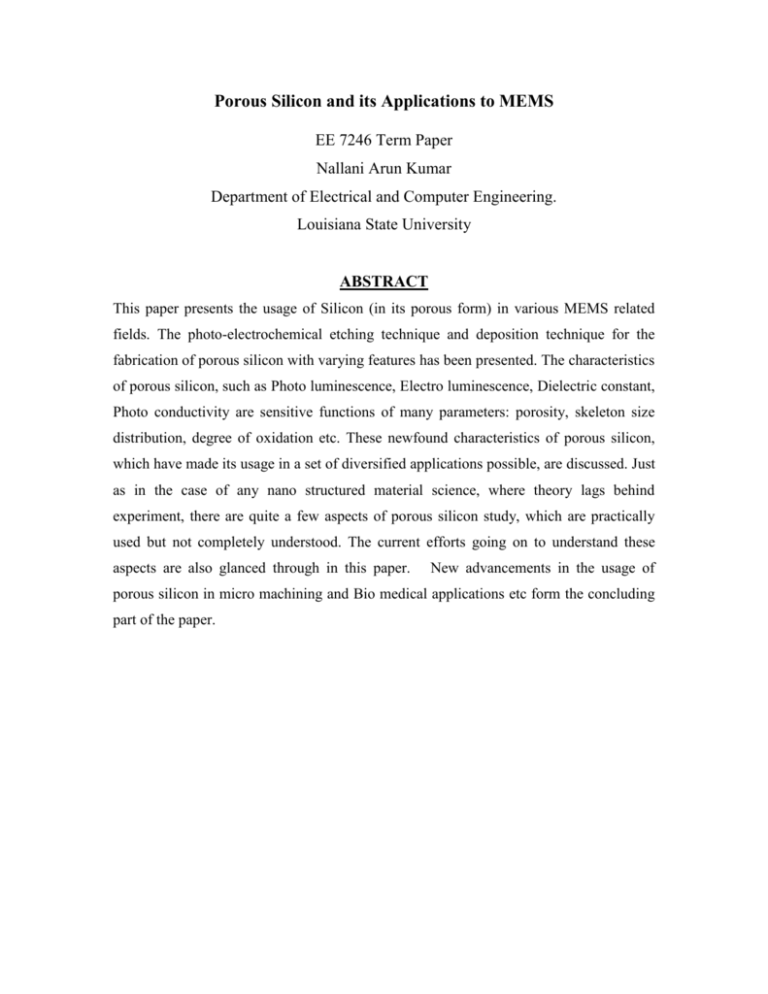
Porous Silicon and its Applications to MEMS EE 7246 Term Paper Nallani Arun Kumar Department of Electrical and Computer Engineering. Louisiana State University ABSTRACT This paper presents the usage of Silicon (in its porous form) in various MEMS related fields. The photo-electrochemical etching technique and deposition technique for the fabrication of porous silicon with varying features has been presented. The characteristics of porous silicon, such as Photo luminescence, Electro luminescence, Dielectric constant, Photo conductivity are sensitive functions of many parameters: porosity, skeleton size distribution, degree of oxidation etc. These newfound characteristics of porous silicon, which have made its usage in a set of diversified applications possible, are discussed. Just as in the case of any nano structured material science, where theory lags behind experiment, there are quite a few aspects of porous silicon study, which are practically used but not completely understood. The current efforts going on to understand these aspects are also glanced through in this paper. New advancements in the usage of porous silicon in micro machining and Bio medical applications etc form the concluding part of the paper. 1.1 Introduction We are now in position to clearly see that silicon technology that uses silicon in its bulk crystalline form is rapidly coming to its saturation point. We are in fast need of another superior material that can cater to the high demands of the rapidly changing technology. By rendering this bulk crystalline form of silicon in to a porous structure, a new variety of characteristics such as magnetic, optical, luminescent characteristics can be observed, which can ensure the survival of silicon for a long time to come. The ability to emit light efficiently and to promote tissue growth are two disparate examples of this. One of the primary methods of porous silicon manufacture is anodic Electro-chemical Etching in Ethanoic HF. This process is also known as anodization, as the silicon that is to be rendered porous is made the anode. In some cases illumination is required to enhance/ cause the etching reaction. The characteristics of porous silicon formed heavily depend on the anodization conditions and also on the wafer type. The other relatively recent and different approach used by present inventors is to actually deposit porous films with "as-grown" controlled porosity. They claim that this method of porous silicon growth has a number of technological and economic advantages compared to conventional porous silicon fabrication technique. The different types of porous silicon formed due to variations formed in the etching/ deposition conditions can be classified (IUPAC classification) into three categories viz.: Pore size range 1. Micro porous silicon < 2 nm 2. Meso porous Silicon and 2 - 50 nm 3. Macro porous silicon. > 50 nm The dependence of porosity on the resistivity of silicon wafer is shown below: - Macro porous Meso porous Micro porous This classification is essentially based on the pore size of the resulting pore on the silicon wafer. The amount of void content (porosity) of the porous structure is one more method of classifying porous silicon: Void Content 1. Low porosity 0 - 30 % 2. Medium porosity 30-70 % 3. High porosity 70-100% The pore structure and the porosity essentially contribute to the different characteristics to the parent material viz. silicon thus determining their applications. Porous Silicon having low porosity has the property of having high specific surface area which facilitates its usage in micro-capacitors, wafer bonding and tissue bonding, where the high surface area is a critical aspect. Medium porosity silicon is easy to fabricate and Acts as an excellent sacrificial layer in micro machining techniques. Thus this is extensively used in micro machining, micro sensors and silicon on insulator structures. High porosity silicon has the exciting and unique feature of luminescence and that too at visible ranges. There are about 1500 papers published on visible photoluminescence of porous silicon seeking to clarify the origin of this emission in the last seven years. This plethora of different models clearly illustrates the controversy that is existing regarding this characteristic. 2 Formation Techniques of Porous Silicon: 2.1 Photo Electrochemical Etching Porous Silicon is formed on a silicon substrate during anodization in an Ethanoic hydrofluoric acid electrolyte. Pore formation is only observed for anodic current densities below a critical current density. The typical cells used for this are shown below. The cell just above facilitates backside illumination onto the wafer that is essential for the formation of macro-pores. The size distribution of etched porous structure depends sensitively on parameters such as doping kind, current density, illumination conditions etc. 2.1.1 Pore Formation physics. Macro pore formation in silicon electrodes is characterized by a depletion of the porous region due to space charge effects and a constant current density at the pore tips, indicating a steady state condition between charge transfer and mass transport. This is in contrast to the case of micro porous silicon where the depletion of the pore walls is due to quantum confinement and the current density at the pore tips is always lesser than the applied current density. Holes are required to promote dissolution. Illumination is thus needed for n type materials to be etched as it generates the holes required for dissolution. Illumination from the backside is considered to be superior to front side illumination because in the latter case carriers are generated in the pore walls which leads to further dissolution in that region. The location of macro pores on a <100>-silicon wafer can be pre determined by etch pits. The well-known inverted pyramids generated by alkaline etching are sufficient to initiate pore growth. 2.1.2 Limitations The possibility to control pore initiation and pore geometry gives a high degree in design. How ever there are a few limitations inherent to the electrochemical pore formation. a) The pore cross section can vary between a circle and a four armed star depending on the formation conditions, as shown below The pore can also break up into sub branches, which can be seen, in the last cross section. The pores can be made more circular by oxidation steps or can be made more square by anisotropic chemical etching for example in aqueous HF. Branching of pores can be suppressed by an increase of current density or an increase in doping density, bias or HF concentration. b) The growth rate of the pore obtained on an average is about 1 micrometer per minute, which could be slow for certain applications. If pores all along the wafer are needed, the etching should go on for about a day. c) The pore growth direction is controlled by the crystal orientation and also by the direction of illumination. When both these factors do not sync, i.e. don’t cause same direction of pore growth, branching of the pore may occur especially for <110> or <111> oriented substrates. 2.2 Pore formation by Layer deposition This new low temperature method for the production of controlled porous polycrystalline silicon on flexible substrates has caused lot of interest in bio-MEMS field. In this method porous silicon is actually formed by deposition of porous silicon films with as-grown controlled porosity. These films are a deposited columnar material whose pores are the voids between the columns. The pores are not "worm holes" of random lengths but controlled-size voids. This process has the ability of producing almost perfectly uniform diameter columns and pores of nanometer range. The films deposited are seen to be stable polycrystalline silicon that can effectively be doped n-type or p-type. A TEM micrograph of a typical example (deposited on a glass substrate at 120 oC) of one of the films produced by deposition is shown below. The white regions are the voids (about 30 Ao) in the film. The columns are seen to be polycrystalline and about 80 Ao in diameter. 2.2.1 Advantages Compared to currently prevalent "worm-hole" porous crystalline deposited columnar silicon films, this new material offers the following advantages: Relatively high degree of porosity (up to 75%) Low temperature process (films can be deposited on plastics, metals foils etc) Can be deposited on flexible substrates Controls of void size and void fraction (pore sizes down to nanometer range) Lack of anodization- based wet etching Films can be doped n-type or p-type Films can be modified with chemical processing(i.e. oxidation , silicidation, nitration, etc.) Film properties (chemical activity, mechanical strength, etc.) can be modified by subsequent film coatings 3.1 Applications of Porous silicon The application areas of porous silicon are, as mentioned above, very diversified. They can be classified into the following broad categories a) Micro electronic applications b) Optical applications c) Optoelectronic applications d) Sensor applications e) Biomedical applications f) Micro machining applications g) Solar cell technology etc. All of these are directly or indirectly linked to many MEMS applications. A description to few of the applications that are directly linked to MEMS is given below 3.1.1 Micro- machining applications: The etching of small mechanical parts in silicon has become has become an important research topic in the field of micro mechanics. Various methods have been developed that have gradually decreased the size of micro machines and improved their quality. 3.1.1.a) Microstructuring with porous silicon The basic idea porous silicon micro machining is as follows: A masking layer for anodization is made and structured. The silicon is made locally porous. On top of the porous silicon thin film technology can be applied to make sensor structures. The porous material is removed. The upper layers are undercut and in this way freestanding structures are made. The advantages of using porous silicon technology over others are mentioned below 1. Membranes can be realized with etching from the front side of the wafer only. The avoidance of double-sided lithography makes the processes easier and allows smaller sensor designs since no wafer space is lost on the slope of the etched planes, as in anisotropic etching in KOH. 2. The process is CMOS compatible. 3. Etch stop can be performed at low doped silicon with out electrical contact of these structures. 4. The removal of porous silicon does not need aggressive chemistry. The selectivity of etching of porous silicon is heavily dependant on the dopant type and concentration. This is because the etching rate is a function of the number of holes in the substrate. The general etching selectivity is given below Etching rate Doping Light during etching Very High n+ No influence High p+ No influence Medium p or n Illuminated Low p Dark Very Low n Dark Few of the structures made by using porous silicon as sacrificial layer are shown below We can clearly see the sharp and crisp edges that have been made possible due to the usage of porous silicon as the sacrificial layer. 3.1.2 Optical applications Micro porous silicon that has pores that can be compared to the wavelength of visible light displays some interesting active and passive optical properties. 3.1.2 .a) Usage of Porous silicon as a passive optical device: The fact that the porosity is proportional to the refractive index opens a new and interesting direction in the development of passive optical components. This property can be used in fabrication of passive optical components such as interference filters and diffraction gratings. Porous silicon Multi-layers (PSMs) having different refractive indices are deposited one over the other thus making a Bragg reflector (interference filter) kind of a structure in micro dimension scale. The reflectance spectrum of the above structure is as follows. Using this kind of structure, interference filters for the Infrared, Visible and Ultraviolet regions can be formed. Its low cost, high quality and ease of treatment make it an ideal structure for space applications 3.1.2.b) Usage of Porous silicon as an Active Optical Device Nano-Porous silicon as an active optical device has been recognized only in the recent years. Properties such as Electro-luminescence, Photo-luminescence, Cathodoluminescence etc, which are not exhibited by the parent silicon bulk material, have been distinctly observed in the visible range at room temperature. The reason for this kind of luminescence has not yet been properly understood. There are quite a few models, which have offered to explain this phenomenon. They can be broadly classified into four classes viz.: 1. Those based on quantum confinement alone. 2. Nanocrystal surface states 3. Specific defects or molecules and 4. Structurally disordered states. Photo luminescence spectra of porous silicon compared to a good photo luminescent material (polysilane) and bulk silicon LEDs The result of this property is the new "on-chip" silicon LED. The device constructions and fabrication methods exhibiting the most promise for active Optical / Optoelectronic applications have been patented. Today the objectives of research on PS based LED's are: (I) Increase of External Quantum Efficiency (EQE) (II) Increase of life time and (III) Increase of speed. Once these aspects are achieved, which seem very likely in the near future, these LED's can be used for high-level optical display systems. Wave Guides The Porous structure of porous silicon can also be used as an excellent wave-guide on the chip. Many kinds of micro-sized wave-guides such as (splitters, couplers, modulators etc.) have been fabricated and patented. Photo detectors The porous silicon has the property of changing its spectral characteristics and adsorbance when exposed to light (Photons). This property can be to convert light to electric oscillations that can be suitably amplified and processed. Thus porous silicon can be used as a photo detector. 3.1.3 Application of Porous silicon in sensors The large specific surface to volume ratio of porous silicon renders it to be used for making sensing applications. Large sensing capability in a small area enables these kinds of sensors to be placed in such places where it is difficult for a macro-sensing device to be used. The porous silicon is used as the dielectric between the plates of a capacitor. The deposition of any material on the porous silicon alters the dielectric constant of the material, thus changing the capacitance of the capacitor. A broad schematic diagram of a typical humidity sensor that works on this principle is give below: - Porous silicon is integrated as dielectric layer in a capacitive sensor. Due to an increase of the relative humidity some molecules of water will condensate in the pores of the porous silicon layer. This results in a non-linear change of the capacitance. It has been demonstrated that the sensitivity of the type of humidity sensor is very high. 3.1.4 Porous Silicon as a Bio- MEMS material Micro porous silicon can be used for the growth of living tissue in its pores. The materials lack of toxicity, coupled with the ability to culture mammalian cells directly onto porous silicon offers exciting possibilities for the future of biologically interfaced sensing. This could lead to 'bionic' limb replacements and electronic sensing devices for checking body chemistry and potentially viewing images and sounds. Should further trials be successful porous silicon could be used to bridge the gap between a mechanical device and human tissue by transmitting the signals and information from a device to the nervous system and back again. 4.1 Conclusion The invention of the solid state transistor and then the IC some fifty years ago have revolutionized our living styles today. The discovery of very exciting properties of porous silicon as visible luminescence at room temperature and the ability to grow tissue in it etc clearly pin point to another revolution in the very near future. These attributes have given a rebirth to interest in silicon and there is active research going on all over the globe for more and more useful micro applications of the fascinating material. These new features of porous silicon have been observed and practically useful devices have been made. But the actual explanation for these characteristics is yet to be understood. There have been models explaining these phenomenon, but nothing concrete has been obtained until today. Continued efforts to understand these are going on round the clock in various parts of the globe. The day these observations are quantitatively and qualitatively understood, another revolution of equal or maybe larger proportion is bound to come! References: 1. Properties of Porous Silicon - EMIS Datareviews Series no. 18 Edited by LEIGH CANHAM 2. Porous silicon - a new material for MEMS -1996 IEEE MEMS V Lehmann 3. Micro Optical applications of porous silicon - IEEE/LEOS 1996 Thanissen,M.;Berger,M.G. .. 4. A novel technique for fabricating semiconductor nanodevice array on silicon IEEE/Cornell Conference on Advanced concepts - McGinnis,S.P.; Das,B 5. Photoluminescence mechanisms in porous silicon - Electron devices and materials symposium- 1994 - Chi-Huei Lin; Si Chen lee 6. Fabrication of Free Standing structure using single step electrchemical etching in HF IEEE - MEMS - H. Ohji, P.J.Trimp 7. A dissolved wafer process using a porous silicon sacrificial layer and a lightly doped bulk silicon etch - stop - T. E. Bell and K.D. Wise 8. Single chip condenser microphone using porous silicon as sacrificial layer for the air gap. 9. On the morphology of porous silicon layers obtained by an electrchemical etching method. - Craciun,G ; Dafinei, A - Semiconductor Conference, 1995 10. Laterrally grown porous polycrystalline silicon : a new material for transducer applications- Anderson, R.C.,Muller, R.S. Tobias,C.W.- Solic state sensors and actuators, 1991 11. Photoluminescence spectrum redshifting of porous silicon layers prepared from diamond scratched samples. 12. Porous silicon Multi layers on narrow vertical walls for Optical Applications Elisabete Gazello, Walter J Salcedo 13. A photoconduction study on porous silicon- Dafinei, A; Carciun,G.; Flueraru,C. // internet resources 14. http://sim.lme.usp.br/publicacoes/1999/pdf/porous%20silicon%20multilayers.pdf 15. http://dmtwww.epfl.ch/ims/micsys/projects/porsi/ 16. http://www.research.psu.edu/ipo/industry/elect.html 17. http://www.sensorscan.com/sensoren/sensoren/humidity_sensor.htm 18. http://esapub.esrin.esa.it/pff/pffv8n1/guerv8n1.htm 19. http://www.instmat.co.uk/press-ab/press/mw/1499psj.htm 20. http://www.wiley.com/technical_insights/reporttocs/poroussilicon.htm 21. http://www.isp.kiev.ua/library/journal/users/pdf/n2_99/88_299.pdf 22. http://www.imsas.uni-bremen.de/projects/posi.html
